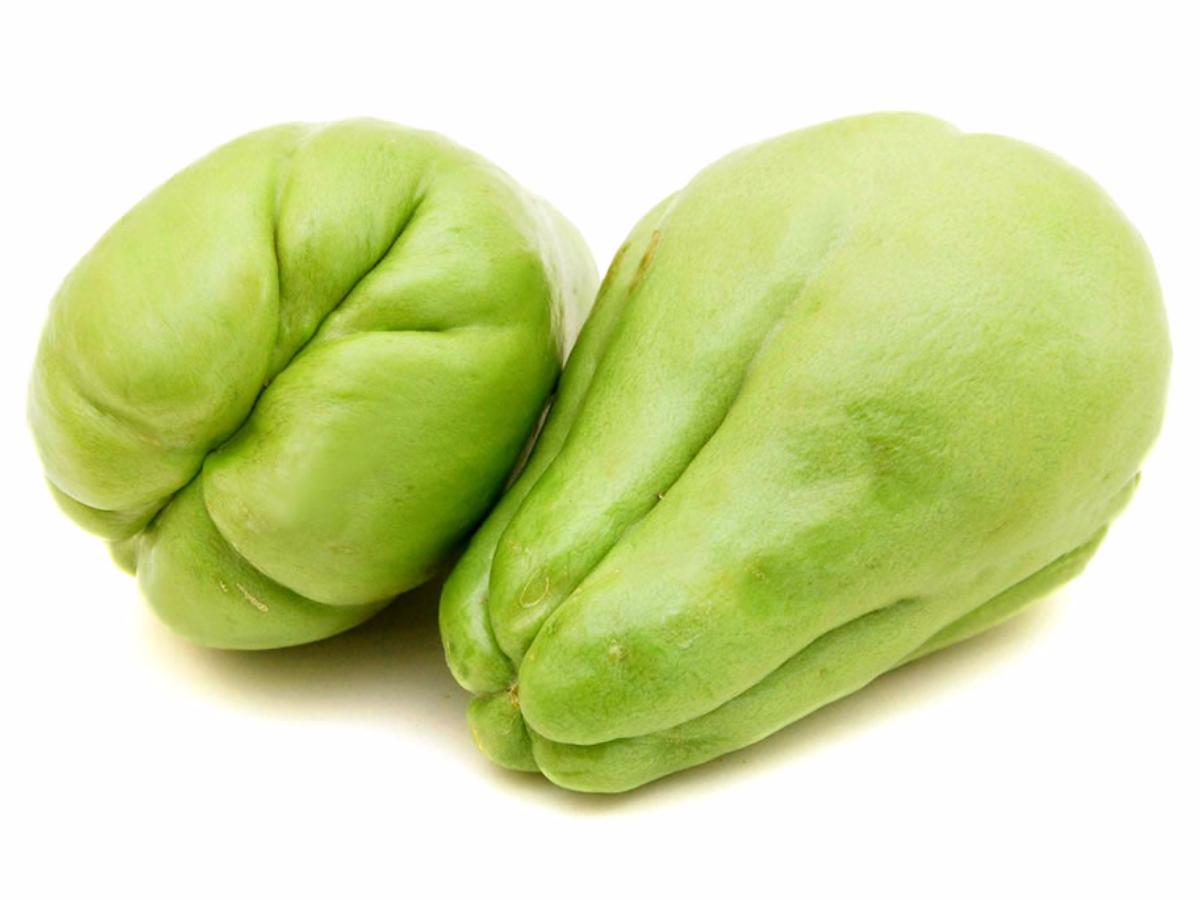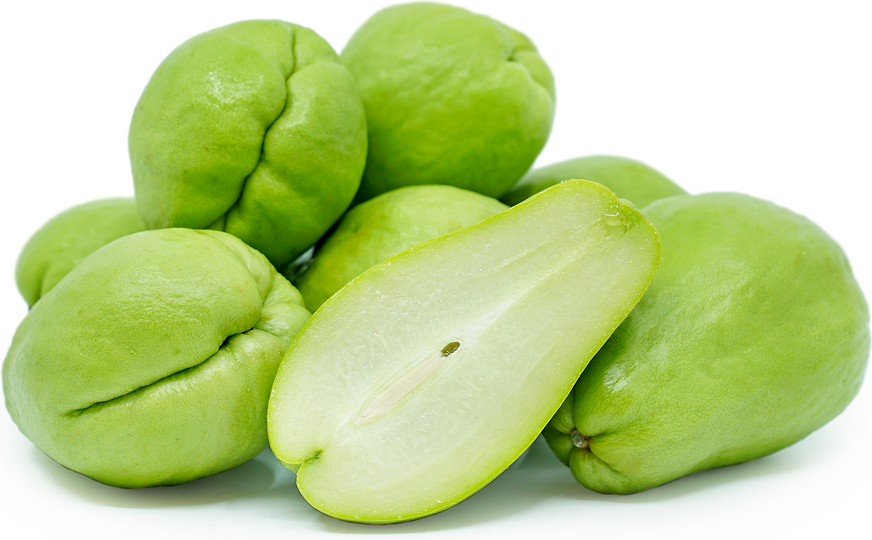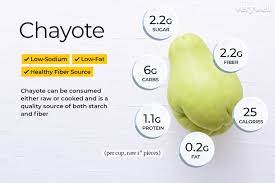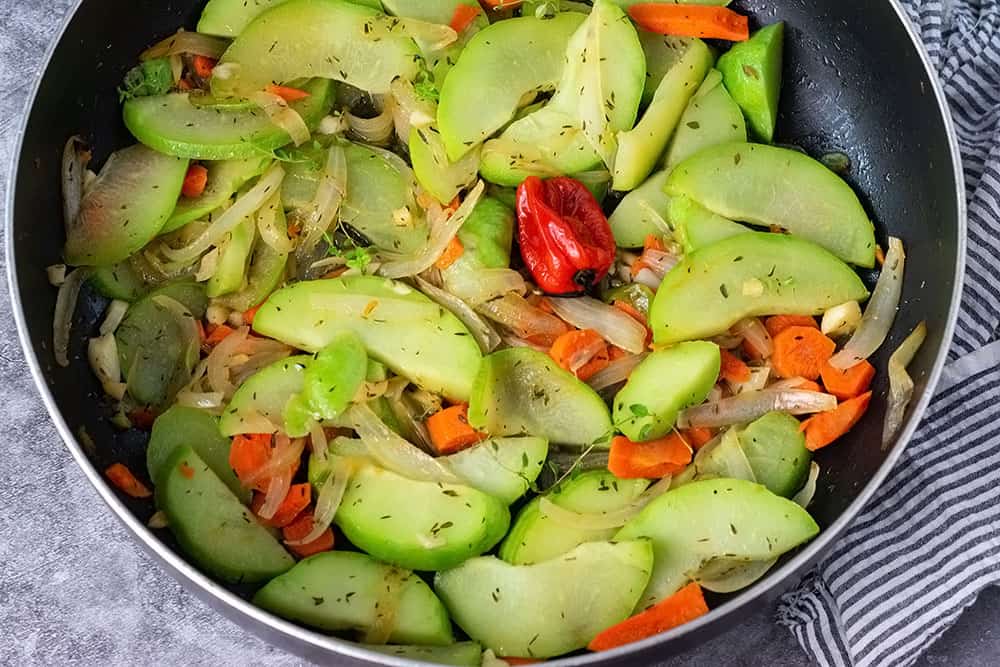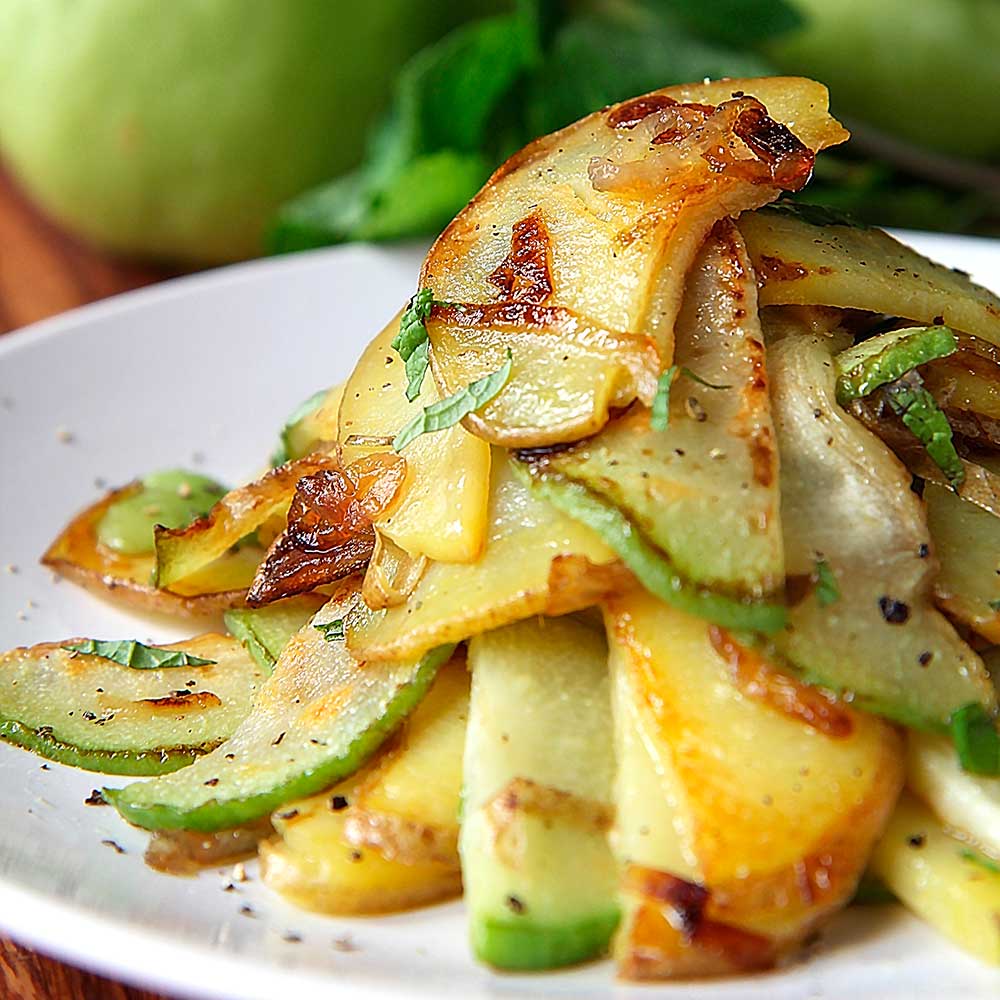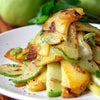Chayote
- Product Weight: 454 g
- Category: Fresh Fruits & Vegetables, Grocery & Gourmet Foods, Vegetables

Chayote (Sechium edule) is a gourd that is often referred to as a vegetable, but technically this bright, green pear-shaped food is a fruit. Chayote squash—also called mirliton—is commonly grown in Mexico or other warm climates and can be consumed either raw or cooked. The root and leaves of this plant are also edible.
If you're looking to experiment with interesting new fruits and veggies, chayote is a smart choice. The fruit is versatile, easy to use, and provides a boost of healthy nutrition along with an interesting flavor and texture.
Nutrition Facts
This nutrition information is provided by the USDA for 1 cup (132g) of raw 1" chayote pieces.
- Calories: 25
- Fat: 0.2g
- Sodium: 2.6mg
- Carbohydrates: 6g
- Fiber: 2.2g
- Sugars: 2.2g
- Protein: 1.1g
Carbs in Chayote
Most of the calories in chayote come from carbohydrates. There are a total of 6 grams of carbs in a one-cup serving and over two grams of healthy fiber. You'll also get a small amount of starch and just over 2 grams of naturally-occurring sugar.
Chayote is a low-glycemic food. The glycemic load of a single cup serving is estimated to range between one and two, regardless of whether it is cooked or raw. A low glycemic food is digested and metabolized slowly and therefore raises blood sugar at a slower rate than foods with higher glycemic indexes.
Fats in Chayote
There is less than one gram of fat in a cup of raw chayote and the very small amount is polyunsaturated. Polyunsaturated fats come from plant sources and are considered to be a healthier source of fat than saturated fat. Health experts advise that we replace saturated fats with polyunsaturated fats when possible to boost heart health and reduce our risk of other chronic diseases.
If chayote is prepared with fats (as many recipes suggest) the fat content will increase, and if butter or another animal fat is used in the preparation, you'll also increase your intake of saturated fat.
Protein in Chayote
Chayote is not a significant source of protein providing just over one gram per serving.
Micronutrients in Chayote
Chayote provides a number of health-boosting vitamins and minerals.
A single serving of chayote provides 123 micrograms of folate or 31% of your recommended daily intake. You'll also get over 10 grams or about 17% of your recommended intake of vitamin C. Other vitamins in chayote include vitamin K, vitamin B6, pantothenic acid, thiamin, riboflavin, niacin, and vitamin E.
Minerals in chayote include manganese, copper, zinc, potassium, and magnesium. There is also a small amount of calcium, iron, and phosphorus in chayote.
Health Benefits
Like many other types of squash, chayote is a good source of fiber. Fiber helps you to feel full and satisfied after eating so that it is easier to maintain a healthy weight. Fiber is also an important nutrient for a healthy digestive system. Studies have established the use of chayote and chayote roots as a quality source of both starch and fiber.
There are ongoing studies that suggest other health benefits of chayote.
A 2019 review published in Food Chemistry investigated chayote's nutritional, phytochemical, and pharmacological properties. Researchers determined that the fruit provides a broad-spectrum of polyphenols including phenolic acids, tannins, and stilbenes. Polyphenols are known to have antiallergic, anti-inflammatory, antiviral, anticarcinogenic and hypoglycemic effects in the body.
Researchers also wrote that clinical and epidemiological studies have established an inverse relationship between the consumption of chayote and the prevalence of chronic diseases. However, the study authors noted that more research is needed to fully understand the medicinal and nutritional potential of chayote and chayote byproducts.
Another 2019 study investigated the potential benefits of chayote consumption in older adults. The research published in the journal Antioxidants concluded that consumption of dried chayote may provide antioxidant and anti-inflammatory effects in older adults with metabolic syndrome. However, the study was small in scope and study authors acknowledge that further studies are needed.
Common Questions
How do you know when chayote is ripe?
Chayote is in season September through May and usually in stores in the winter, although some stores carry them all year long. When choosing the best chayote look for one with bright green skin. The color should be even across the whole fruit. Deep grooves in the skin are okay but it should not have soft spots or bruises and wrinkles shouldn't be loose.
Smaller chayote are generally more flavorful than the larger varieties.
How do I store chayote?
Keep them in the refrigerator—preferably in the crisper drawer. They are usually good for about 10 days.
What does chayote taste like? Does cooking change its flavor?
The fruit is known for its mild flavor. It is often compared to a mix between an apple and a potato. Some even compare it to a cucumber when consumed raw.
Usually, cooking does not change the flavor substantially, unless other ingredients are added. Cooks often add rich or spicy ingredients to it, such as cream, bacon, or red pepper flakes.
Chayote (Sechium edule) is a gourd that is often referred to as a vegetable, but technically this bright, green pear-shaped food is a fruit. Chayote squash—also called mirliton—is commonly grown in Mexico or other warm climates and can be consumed either raw or cooked. The root and leaves of this plant are also edible.
If you're looking to experiment with interesting new fruits and veggies, chayote is a smart choice. The fruit is versatile, easy to use, and provides a boost of healthy nutrition along with an interesting flavor and texture.
Nutrition Facts
This nutrition information is provided by the USDA for 1 cup (132g) of raw 1" chayote pieces.
- Calories: 25
- Fat: 0.2g
- Sodium: 2.6mg
- Carbohydrates: 6g
- Fiber: 2.2g
- Sugars: 2.2g
- Protein: 1.1g
Carbs in Chayote
Most of the calories in chayote come from carbohydrates. There are a total of 6 grams of carbs in a one-cup serving and over two grams of healthy fiber. You'll also get a small amount of starch and just over 2 grams of naturally-occurring sugar.
Chayote is a low-glycemic food. The glycemic load of a single cup serving is estimated to range between one and two, regardless of whether it is cooked or raw. A low glycemic food is digested and metabolized slowly and therefore raises blood sugar at a slower rate than foods with higher glycemic indexes.
Fats in Chayote
There is less than one gram of fat in a cup of raw chayote and the very small amount is polyunsaturated. Polyunsaturated fats come from plant sources and are considered to be a healthier source of fat than saturated fat. Health experts advise that we replace saturated fats with polyunsaturated fats when possible to boost heart health and reduce our risk of other chronic diseases.
If chayote is prepared with fats (as many recipes suggest) the fat content will increase, and if butter or another animal fat is used in the preparation, you'll also increase your intake of saturated fat.
Protein in Chayote
Chayote is not a significant source of protein providing just over one gram per serving.
Micronutrients in Chayote
Chayote provides a number of health-boosting vitamins and minerals.
A single serving of chayote provides 123 micrograms of folate or 31% of your recommended daily intake. You'll also get over 10 grams or about 17% of your recommended intake of vitamin C. Other vitamins in chayote include vitamin K, vitamin B6, pantothenic acid, thiamin, riboflavin, niacin, and vitamin E.
Minerals in chayote include manganese, copper, zinc, potassium, and magnesium. There is also a small amount of calcium, iron, and phosphorus in chayote.
Health Benefits
Like many other types of squash, chayote is a good source of fiber. Fiber helps you to feel full and satisfied after eating so that it is easier to maintain a healthy weight. Fiber is also an important nutrient for a healthy digestive system. Studies have established the use of chayote and chayote roots as a quality source of both starch and fiber.
There are ongoing studies that suggest other health benefits of chayote.
A 2019 review published in Food Chemistry investigated chayote's nutritional, phytochemical, and pharmacological properties. Researchers determined that the fruit provides a broad-spectrum of polyphenols including phenolic acids, tannins, and stilbenes. Polyphenols are known to have antiallergic, anti-inflammatory, antiviral, anticarcinogenic and hypoglycemic effects in the body.
Researchers also wrote that clinical and epidemiological studies have established an inverse relationship between the consumption of chayote and the prevalence of chronic diseases. However, the study authors noted that more research is needed to fully understand the medicinal and nutritional potential of chayote and chayote byproducts.
Another 2019 study investigated the potential benefits of chayote consumption in older adults. The research published in the journal Antioxidants concluded that consumption of dried chayote may provide antioxidant and anti-inflammatory effects in older adults with metabolic syndrome. However, the study was small in scope and study authors acknowledge that further studies are needed.
Common Questions
How do you know when chayote is ripe?
Chayote is in season September through May and usually in stores in the winter, although some stores carry them all year long. When choosing the best chayote look for one with bright green skin. The color should be even across the whole fruit. Deep grooves in the skin are okay but it should not have soft spots or bruises and wrinkles shouldn't be loose.
Smaller chayote are generally more flavorful than the larger varieties.
How do I store chayote?
Keep them in the refrigerator—preferably in the crisper drawer. They are usually good for about 10 days.
What does chayote taste like? Does cooking change its flavor?
The fruit is known for its mild flavor. It is often compared to a mix between an apple and a potato. Some even compare it to a cucumber when consumed raw.
Usually, cooking does not change the flavor substantially, unless other ingredients are added. Cooks often add rich or spicy ingredients to it, such as cream, bacon, or red pepper flakes.



